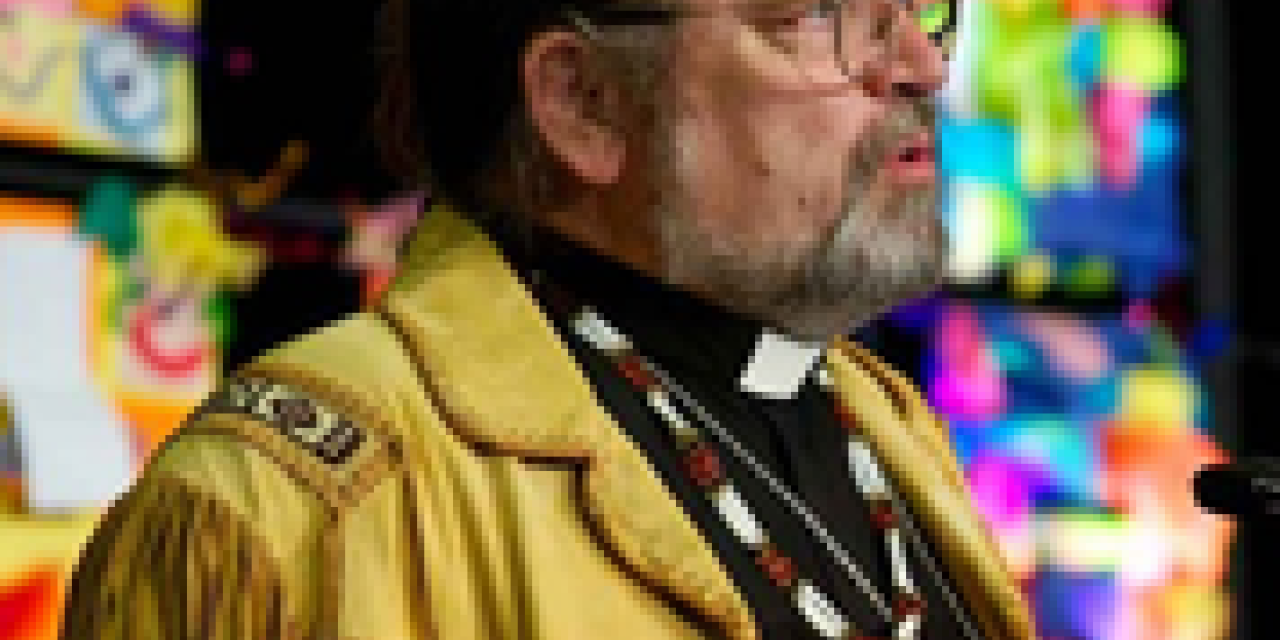Mark L. MacDonald became Canada’s first National Indigenous Anglican Bishop in 2007. He is now an archbishop and is the World Council of Churches’ president for North America. MacDonald writes often about Christian worship, inculturation, and leadership in First Nations churches. In this edited conversation, MacDonald explains how Indigenous Christians center their worship and church life on the good news of Jesus.
How do you define “inculturation”?
Put in its most simple form, inculturation is the Word made flesh. It describes a process of receiving into a culture the gospel and life of Jesus. In this, it affirms the presence of the Word prior to the reception of the gospel. At the same time, it challenges and transforms culture to more adequately express the fullness of the revelation of Jesus. Inculturation involves all aspects of culture—music, art, and movement—expressing the good news of Jesus in a way that allows people to see it clearly.
Inculturation happens on many levels, often without notice or planning. Preaching styles change to reflect how modern audiences listen. Music changes, reflecting the patterns and tastes of modern listeners. This has been going on for a long time. Many aspects of Christmas, Easter, and other major Christian celebrations reflect the values and ideals of Christian life being expressed in church, family, and wider community celebrations. The Christmas tree, wreath, and many Christmas carols and hymns reflect inculturation.
What worship practices or theological insights from Indigenous Anglicans might bless the wider church?
Indigenous Christians have revealed many worship practices and theological insights. One is Indigenous Gospel-Based Discipleship, where the reading of the gospel three times with group engagement is the context for meeting and gatherings. Indigenous music styles help modern people receive the message in music. Indigenous congregations understand and use “ceremonial time” differently than modern people do. Worshipers forget the clock, which allows a non-anxious entrance into awareness of God’s presence.
How does Gospel-Based Discipleship compare with lectio divina? Do some Indigenous worship services use this in place of a sermon or homily?
Gospel-Based Discipleship (GBD) was developed with a two-fold sense of purpose and vocation. First, it would be the center point of all our work—a way of governance and community, and a way of life. Second, because institutional churches were pulling their resources out of Indigenous communities, we needed a way to allow small communities with meager resources to gather and engage the gospel. GBD is similar to lectio divina, though we follow a slightly different process, and we use the Gospel of the Day from our church’s lectionary of readings.
Because of the doctrine of discovery and other harmful ideas, Christian denominations and traditions often privilege some cultures over others. How has this harmed Indigenous churches?
For many years—in some cases, for centuries—churches have demanded that Indigenous Christians follow Western practices and values in their churches. Where this has been strictly followed, it has meant a limitation on the growth of Christian disciples and discipleship. At times, Western practices like parliamentary procedure have eclipsed or eliminated Indigenous forms of leadership and authority. This has been disastrous.
How does parliamentary procedure conflict with Indigenous forms of leadership and authority?
Indigenous communities tend to make decisions by first setting a sacred context for the gathering. We do this by GBD, and quite often the answers come out of engaging with the gospel. At the very least, engaging with the gospel illuminates the questions that the gathering is considering. Second, decisions are made by consensus, with a strong trust in the covenant between the gathered people.
There is an important aspect that is distinctive. The gatherings give special place to the elders. They can intervene at any time and, generally, can speak as long as they like. Some communities privilege the voice of women. It happens on occasion that youth make an intervention, and they are also listened to carefully. (This, I believe, is a modern element.) Our sacred circle, first and foremost, recognizes the authority of Jesus’ presence in the gathering, heard through the voices of the people who engage the gospel. This often happens through the voices of elders, who may mention dreams and other divine interventions.
What do you mean by “sacred circle”?
I’ll quote from the Rule of Life (p. VI) in A Disciple’s Prayer Book, developed by the Anglican Council of Indigenous Peoples:
Creator God, we acknowledge and give thanks that:
In Jesus we know we belong to a Sacred Circle with the Gospel and Baptismal Covenant in the Center.
In this Sacred Circle:
We are all related;
We live a compassionate and generous life;
We respect all life, traditions, and resources;
We commit ourselves to spiritual growth, discipleship, and consensus.
What’s an example of how dismissing Indigenous gifts has harmed churches with more power and privilege?
Because many Western Christians have equated Western culture with Christian faith, Christians often accept ideas and teaching with no biblical foundation. Western ideas of wealth, war, and marriage are examples. At times, this has allowed Christians to participate in practices that cause great harm—things like colonization, for example.
How can churches, Indigenous or not, begin to heal from these structural injustices?
Return to the simple reading and reception of the gospel. This must begin with openly acknowledging that we often are led away from its simplicity and power. Even more importantly, we need to trust Jesus’ promise to be present as teacher, healer, and ruler of our gatherings.
LEARN MORE
Hear Mark MacDonald speak in a panel discussion about loving neighbors through worship (start at 00:10:00) at the 2020 Calvin Symposium on Worship. Mark MacDonald edited The Chant of Life: Inculturation and the People of the Land. Read his chapters in The Gospel after Christendom: New Voices, New Cultures, New Expressions, edited by Ryan K. Bolger, and Green Shoots out of Dry Ground: Growing a New Future for the Church in Canada, edited by John P. Bowen.

